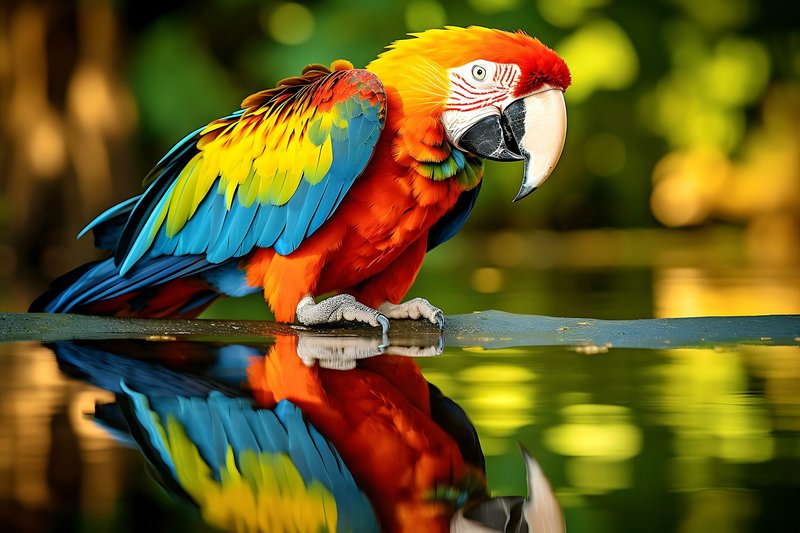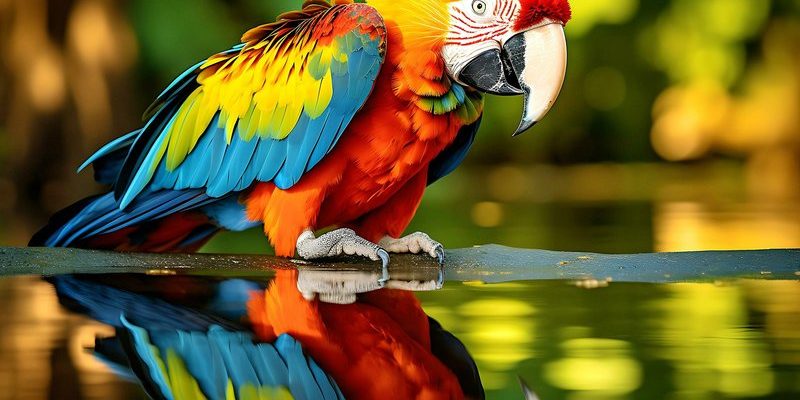
Have you ever seen a macaw? If you have, you probably remember its dazzling colors and lively personality. Macaws are not just any birds; they are vibrant and intelligent creatures with a flair for making a grand entrance. With striking feathers that catch the sunlight and a personality as bright as their colors, macaws captivate anyone lucky enough to encounter them. They are often regarded as some of the most beautiful birds on the planet, and their playful nature makes them incredibly popular pets, too.
These amazing birds hail from the tropical rainforests of Central and South America. They belong to the parrot family, which explains their intelligence and ability to mimic sounds. Their striking appearance and charming antics make them a favorite among bird enthusiasts. But there’s so much more to macaws than just their looks! Let’s dive deeper into their world to learn about their habitat, diet, behavior, and much more.
What Are Macaws?
Macaws are large, long-tailed parrots known for their vibrant plumage. There are several species of macaws, each with its unique color patterns and sizes. Generally, macaws are known for their bright blue, red, green, and yellow feathers, which help them stand out in the lush green canopies of their rainforest homes. These birds can reach up to three feet in length, depending on the species, making them one of the largest types of parrots.
In addition to their striking appearance, macaws are social birds, often seen in pairs or small groups. They communicate using a series of loud calls and whistles that echo through the forests. Their strong beaks allow them to crack open tough nuts and seeds, which form a large part of their diet. Macaws are also highly intelligent, capable of solving problems and even learning to mimic human speech.
Macaw Species
There are about 17 different species of macaws, each with its distinct features. Some of the most well-known species include the Blue-and-yellow Macaw, Scarlet Macaw, and Green-winged Macaw. Here’s a quick rundown of some popular macaw species:
| Species | Color | Size | Habitat |
| Blue-and-yellow Macaw | Bright blue and yellow | About 30 inches | Tropical rainforests |
| Scarlet Macaw | Red, yellow, and blue | About 33 inches | Rainforests and woodlands |
| Green-winged Macaw | Red, green, and blue | About 40 inches | Tropical forests |
| Military Macaw | Green with red accents | About 28 inches | Lowland tropical forests |
Each species has unique characteristics, so knowing what to expect can help you appreciate these wonderful birds even more. For instance, the Scarlet Macaw is famous for its stunning red feathers and loud calls, while the Blue-and-yellow Macaw is loved for its friendly personality and striking colors.
Habitat and Range
Macaws primarily inhabit tropical and subtropical regions, preferring the dense canopies of rainforests. They are typically found in countries like Brazil, Colombia, Peru, and Ecuador, where they can easily access their favorite foods. Macaws thrive in environments that provide plenty of tall trees for nesting and abundant fruits and nuts. They often build their nests high up in the treetops, where they feel safe from predators.
Unfortunately, habitat loss due to deforestation poses a significant threat to macaws. As their natural habitats disappear, they struggle to find food and nesting sites. Conservation efforts are crucial in protecting these birds and their environments. Many organizations work tirelessly to preserve tropical rainforests and help restore macaw populations in the wild.
Diet and Feeding Habits
Macaws are primarily herbivores, feeding on a variety of fruits, nuts, seeds, and flowers. Their strong beaks are perfectly adapted for cracking open hard shells and accessing the tasty treats inside. For instance, they love to munch on palm nuts, which provide essential fats and nutrients. They also enjoy berries and the seeds of various plants, making them an important part of their ecosystem as they help in seed dispersal.
In the wild, macaws spend a good portion of their day foraging for food. They have a keen sense of sight, which helps them spot ripe fruits from high in the trees. When they find a food source, they often gather in large groups, using their loud calls to communicate and share the discovery with others. This social feeding behavior not only helps them find food but also strengthens their bonds with each other.
Behavior and Social Structure
Macaws are known for their social and playful behavior. They often form strong bonds with their mates and can be seen engaging in playful activities like swinging from branches, playing catch with objects, and grooming each other. Social interaction is vital for their mental stimulation, which is why they thrive in pairs or small flocks.
Their vocalizations are another remarkable aspect of their behavior. Macaws communicate through a variety of sounds, including squawks, whistles, and even imitations of other birds or animals. This ability to mimic sounds is not just fun; it helps them stay in touch with their flock members and alert them to potential dangers.
Breeding and Reproduction
During mating season, macaws engage in intricate displays to attract a partner. Courtship involves elaborate dances, posturing, and vocalizations that showcase their fitness and appeal. Once paired, macaws typically mate for life, returning to the same nesting sites year after year.
Breeding usually occurs in large tree cavities, where the female lays two to four eggs. Both parents are involved in incubating the eggs, which hatch after about 24 to 28 days. Once the chicks are born, they are completely reliant on their parents for food and protection. The young macaws fledge, or leave the nest, around three months after hatching, but they often stay close to their parents for several more months as they learn the ropes of foraging and survival.
Conservation Status
Many macaw species are facing serious threats due to habitat loss and illegal trapping for the pet trade. The Blue-and-yellow Macaw, for example, while still relatively common, has seen significant declines in certain areas. Other species, like the Spix’s Macaw, are critically endangered and may be extinct in the wild.
Conservation efforts are vital to ensure the survival of these magnificent birds. Many organizations focus on habitat restoration, protecting existing populations, and raising awareness about the dangers of the illegal pet trade. By supporting these efforts, we can help secure a future for macaws in the wild.
Fun Facts About Macaws
Macaws are full of surprises! Here are a few fun facts that will make you appreciate them even more:
- Macaws have a lifespan of 30 to 50 years, with some living even longer in captivity!
- They can eat up to 10% of their body weight in food each day, thanks to their active lifestyle!
- Macaws have excellent memories, which allows them to remember where food sources are located.
- They are one of the few bird species capable of using tools to assist with feeding.
These traits make macaws not just beautiful, but fascinating creatures to observe and learn about.
FAQ
What do macaws eat in the wild?
In the wild, macaws primarily eat fruits, nuts, seeds, and flowers. They are particularly fond of palm nuts, which provide essential nutrients. Their strong beaks allow them to crack open hard shells to access the food inside. Foraging for food is a social activity for macaws, and they often gather in groups to share food resources.
How long do macaws live as pets?
As pets, macaws can live between 30 to 50 years, with some individuals even living longer. This long lifespan means that potential owners need to be committed to caring for them for many years, providing a stable environment, proper diet, and social interaction to keep them healthy and happy.
Are macaws good pets?
Macaws can make wonderful pets for those who understand their needs. They are very social birds, requiring a lot of attention and interaction. However, they can also be loud and require ample space to thrive. A potential owner should consider their lifestyle and environment before deciding to bring a macaw home.
Why are macaws endangered?
Macaws face numerous threats, including habitat loss due to deforestation and agricultural expansion. They are also at risk from illegal trapping for the pet trade. Over time, these factors have led to significant declines in several macaw species, making conservation efforts crucial for their survival.
Can macaws talk?
Yes, macaws are known for their ability to mimic human speech and other sounds. They can learn to say words and phrases, especially if they are regularly exposed to human interaction. Each macaw’s ability to “talk” can vary significantly based on individual personality and socialization.
Do macaws need special care?
Yes, macaws require specialized care. They need a balanced diet, plenty of social interaction, and mental stimulation to thrive. They also need large cages to accommodate their size and to allow for plenty of movement. Regular veterinary check-ups are important to keep them healthy.
What is the biggest macaw species?
The biggest macaw species is the Hyacinth Macaw. This stunning bird can reach lengths of about 40 inches and is known for its beautiful cobalt blue feathers. Despite its size, the Hyacinth Macaw is gentle and social, making it an enchanting sight in the wild.
Are all macaws brightly colored?
While most macaws are famous for their stunning colors, not all are brightly colored. Some species, like the Military Macaw, have more muted green tones. However, even these birds have their unique charm and beauty.
What can I do to help protect macaws?
To help protect macaws, you can support conservation organizations working to preserve their habitats and educate the public about their plight. Avoid purchasing macaws from pet stores that may source them illegally, and if you’re considering adopting a macaw, make sure it’s from a reputable rescue or breeder.
Do macaws have any natural predators?
In the wild, macaws face threats from various predators, including hawks, eagles, and larger snakes. However, their bright colors often help them blend in with the foliage, making it more challenging for predators to spot them. Their social behavior also plays a key role in helping them avoid danger as they alert each other to potential threats.
How can I learn more about macaws?
To learn more about macaws, you can read books, visit reputable websites dedicated to bird conservation, or even participate in birdwatching activities. Many zoos and aviaries offer educational programs about these fascinating birds, providing an excellent opportunity to see them up close and learn more about their behavior and ecology.

